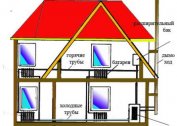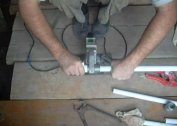A country house is the dream of any urban family, and today very many can afford this pleasure. At the same time, this is not about a banal cottage, which is adapted only for summer holidays, but about a real winter home. You can also leave aside the elite cottages, whose share in suburban construction, despite the huge number of advertising brochures, is rather miserable. We are talking about the so-called budget developers who save literally every penny and are not able to afford the highest quality materials, but at the same time they are trying to build a house that would not require excessive heating costs during the winter.
The huge capacity of the construction industry today is aimed at providing the suburban segment of this market. Especially for the “public sector” “light” types of concrete were invented, which, according to the manufacturers, are able to provide high quality low-cost buildings. The assortment of insulation materials, as well as waterproofing materials, which to some extent can also contribute to the heat saving of a low-rise building, has greatly expanded. As you can see from the statistics, the most popular for erecting the walls of private houses are aerated concrete and foam concrete blocks, which are much cheaper than brick, and with proper insulation of concrete facades can compete with it. However, as practice shows, the heating costs of any buildings today are very high, even those that are made of wood using frame technology.
Problems of private homes
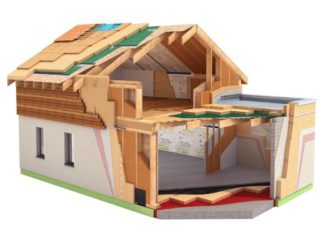 In theory, frame houses are the warmest, but in practice this is far from the case. The heat capacity of the frame walls is very small, so that in such a house it is constantly warm in the winter, it needs to be very well heated, and this is quite a big expense. Someone will say that in northern countries, for example, in Norway and Finland, frame houses occupy more than 90% of the entire segment of suburban construction. This is so, but there houses are heated exclusively by electricity, and electricity in Norway, Sweden or Finland is very cheap, even cheaper than it used to be in the USSR. The fact is that in these countries there are a huge number of rivers, including mountain ones, on which even more power plants of all kinds, both large hydroelectric power stations and miniature, almost private, are built. Thus, these countries are very electrified, and financial means are spent on heating frame houses imperceptibly. For example, in the plains of France or Germany, frame houses are not built, because there are not so many water generators there. The same thing is observed here - if frame houses are being built somewhere in the Moscow Region, it’s only for advertising purposes, but it’s really convenient to live in such houses somewhere in the Crimea or Stavropol region, where winter temperatures rarely drop below zero .
In theory, frame houses are the warmest, but in practice this is far from the case. The heat capacity of the frame walls is very small, so that in such a house it is constantly warm in the winter, it needs to be very well heated, and this is quite a big expense. Someone will say that in northern countries, for example, in Norway and Finland, frame houses occupy more than 90% of the entire segment of suburban construction. This is so, but there houses are heated exclusively by electricity, and electricity in Norway, Sweden or Finland is very cheap, even cheaper than it used to be in the USSR. The fact is that in these countries there are a huge number of rivers, including mountain ones, on which even more power plants of all kinds, both large hydroelectric power stations and miniature, almost private, are built. Thus, these countries are very electrified, and financial means are spent on heating frame houses imperceptibly. For example, in the plains of France or Germany, frame houses are not built, because there are not so many water generators there. The same thing is observed here - if frame houses are being built somewhere in the Moscow Region, it’s only for advertising purposes, but it’s really convenient to live in such houses somewhere in the Crimea or Stavropol region, where winter temperatures rarely drop below zero .
So, the problem of economical heating of private suburban homes in our country is very acute, especially in regions with a cold climate, where frosts are often up to 30 degrees. On such days, heating works with might and main, absorbing significant funds. Of course, wealthy homeowners are not afraid of such expenses, but, as we said, there are less than 10% of all the rest. The bulk of the "public sector" the need to pay large sums for fuel (gas, electricity, coal, or whatever) is a heavy burden, which very often poisons life in a country house, does not allow you to really enjoy the coziness and comfort.
But there is a category of people who cope with this problem quite successfully, attracting the forces of nature to their service. And although they are not very well versed in the physics of natural phenomena and chemistry of substances, they are very good at communicating with their neighbors and construction specialists who know all sorts of secrets of free heating and warming at home. We are, of course, not talking about special tools with low payback, such as solar panels or windmills, although they, of course, can also be used in general business. We will talk about several "old-fashioned" and more modern techniques, with which you can reduce heating costs by 70%, if you approach the matter thoroughly and wisely.
The sun as a heater
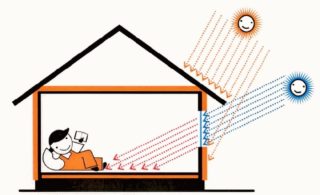 The first method has long been known even to a schoolboy, and is used by some homeowners on a small scale, however, as they say, not to the fullest. It consists in the fact that the sun's rays, penetrating the house through the windows, heat the furnishings that stand in their way. These objects accumulate solar energy, and later give them into the air of the room, heating it. If this effect is used not according to possibilities, but purposefully, then in theory it is possible to heat a house only with sunlight. But this is in theory, but in practice, in winter, the sun does not shine every day in the sky, and on cloudy days you cannot warm the house in this way. However, in any winter there are enough sunny days to significantly reduce the intensity of heating. You can even accumulate energy in the most natural way, which will then be used when the sun is hidden behind the clouds. Some craftsmen put mirrors on the roof that focus the sun's rays on containers of water that heats up and enters the kitchen, bathroom, and even the radiators, depending on what temperature it can be heated.
The first method has long been known even to a schoolboy, and is used by some homeowners on a small scale, however, as they say, not to the fullest. It consists in the fact that the sun's rays, penetrating the house through the windows, heat the furnishings that stand in their way. These objects accumulate solar energy, and later give them into the air of the room, heating it. If this effect is used not according to possibilities, but purposefully, then in theory it is possible to heat a house only with sunlight. But this is in theory, but in practice, in winter, the sun does not shine every day in the sky, and on cloudy days you cannot warm the house in this way. However, in any winter there are enough sunny days to significantly reduce the intensity of heating. You can even accumulate energy in the most natural way, which will then be used when the sun is hidden behind the clouds. Some craftsmen put mirrors on the roof that focus the sun's rays on containers of water that heats up and enters the kitchen, bathroom, and even the radiators, depending on what temperature it can be heated.
But still, the main option is to heat the rooms directly with sunlight. To do this, you just need to put on the south side of the house large windows with reinforced double-glazed windows. Reinforced they are needed so that at night through the windows does not leave heat to the street. Of course, such double-glazed windows are not so cheap - they will have to pay a tidy sum for them. But this money will be beaten off in the first winter, and in the future this option will begin to bring considerable income, which consists in saving fuel. Sunlight should fall on objects that have a high heat capacity and are painted in dark colors. For example, if you put a small cast-iron figurine in front of the window, and direct sunlight falls on it all day, then by sunset it will heat up so much that it simply cannot be picked up. If it is left overnight in a small unheated room, the heat from this figurine will not allow the temperature to drop significantly in the room until morning. Of course, everything here depends on the mass of the heated object, but there are no special problems with this, because solar energy is dimensionless, you can also heat a dark-colored brick wall, which is placed in the room in front of the window. Such a partition will accumulate in itself as much heat as it penetrates through the window, it is for this window that you need to do more.
We use the veranda
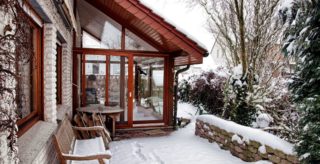 Those homeowners who pre-prepared a project for these purposes and built their energy-saving house not using any special, often incomprehensible and initially expensive technologies save the most on insulation. It is much easier to understand the essence of things and try not to allow conditions that can very cool walls in winter. It is no secret that most of the heat leaves through the walls, and warming will not help much, because the insulation layer is part of the wall, and it is very well cooled by the outside cold air. Therefore, it is necessary to insulate the walls in a more cardinal way, for example, using the veranda.
Those homeowners who pre-prepared a project for these purposes and built their energy-saving house not using any special, often incomprehensible and initially expensive technologies save the most on insulation. It is much easier to understand the essence of things and try not to allow conditions that can very cool walls in winter. It is no secret that most of the heat leaves through the walls, and warming will not help much, because the insulation layer is part of the wall, and it is very well cooled by the outside cold air. Therefore, it is necessary to insulate the walls in a more cardinal way, for example, using the veranda.
A veranda is often a required attribute of any village house.On the veranda in summer you can relax, dine, move the summer kitchen, even on stuffy nights, even sleep on it. But many homeowners use the veranda incorrectly. They place it on the sunny side of the house, and then it turns out that in the summer it is impossible to be on such a veranda because of the heat. And in winter, when it is glazed, the temperature in this room, although higher than on the street, does not contribute to the heat saving of the house, since the main part of the cold passes through the rear, northern wall, which is not lit by the sun even on the brightest days. And when the north wind flies, the heat is blown out of the wall almost uninterruptedly. Therefore, the veranda should be placed exactly along this wall - in winter it will perfectly protect the walls from wind, moisture and freezing, and in summer it will be cool and cozy.
You should also pay attention to the roof, because a lot of heat also goes out through it. In the case of an unheated attic, this is quite easy to do - you need to well insulate the floors and cover them tightly with waterproofing material. But what if the attic is inhabited, because the gentle slopes of the attic are not so easy to insulate - it is possible to create the most airtight carpet from the same mineral wool on the floor. And laying it under the slopes between the rafters, it will not be possible to firmly strengthen the insulation, there will always be cracks between the plates or rolls through which warm air will certainly find its way out. To prevent this from happening, it is enough to take ordinary aluminum foil and glue it to all the slopes and walls, especially you need to try in the corners where the most significant heat leakage occurs. The foil does not absorb heat, but literally reflects it from itself, avoiding leaks, such is the property of this material, which for some reason even today is used in a very small amount, and then mainly in industry, and not in suburban housing construction.
We fill the subfloor with slag
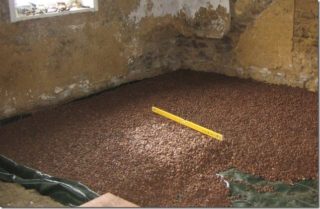 Well, it's time to finally go to the foundation. Heat also passes through the floors, and if the house is without a basement, then it goes directly to the ground. Of course, under the house the soil never freezes and its temperature never drops below zero, especially if the foundation is slab rather than strip. But the problem here is not in the ground, but in thin floors. If the installation of a “warm floor” system is considered in the floor, then cement screed alone can not do here. Do not put ordinary insulation under the screed; it will begin to deteriorate when exposed to heat. Therefore, the best option is to fill the subfloor with a thick layer of slag, which holds heat very well, and if it is excessive, gives it back to the top. The main thing is to make a good waterproofing under a slag layer, which consists of a sand cushion covered with roofing material with glued seams. Slag does not deteriorate either from heat or from cold, it is durable under any conditions and will not allow heat to leak into the underlying soil.
Well, it's time to finally go to the foundation. Heat also passes through the floors, and if the house is without a basement, then it goes directly to the ground. Of course, under the house the soil never freezes and its temperature never drops below zero, especially if the foundation is slab rather than strip. But the problem here is not in the ground, but in thin floors. If the installation of a “warm floor” system is considered in the floor, then cement screed alone can not do here. Do not put ordinary insulation under the screed; it will begin to deteriorate when exposed to heat. Therefore, the best option is to fill the subfloor with a thick layer of slag, which holds heat very well, and if it is excessive, gives it back to the top. The main thing is to make a good waterproofing under a slag layer, which consists of a sand cushion covered with roofing material with glued seams. Slag does not deteriorate either from heat or from cold, it is durable under any conditions and will not allow heat to leak into the underlying soil.
Never line in the hills
 And one more small, but very important nuance. Never build your country house on top of a hill. It is clear that a beautiful view of the surroundings opens from above, but when winter comes with its frosty winds, they will methodically knock out all the heat from the walls and roof of your house, no matter how well they are insulated. Of course, you can plant trees in front of the house in dense rows that will delay the wind, but then the beautiful view from the window will disappear. So what's the point of building a house on a hill?
And one more small, but very important nuance. Never build your country house on top of a hill. It is clear that a beautiful view of the surroundings opens from above, but when winter comes with its frosty winds, they will methodically knock out all the heat from the walls and roof of your house, no matter how well they are insulated. Of course, you can plant trees in front of the house in dense rows that will delay the wind, but then the beautiful view from the window will disappear. So what's the point of building a house on a hill?
Of course, this is far from all the “tricks” with which you can heat a house for free and warm it safely. There are many more different nuances that some smart homeowners use very widely. But even if you take into account all of the above and skillfully apply these methods in the construction and arrangement of your suburban housing, you can save more than half of all the heating costs that your neighbors spend.
